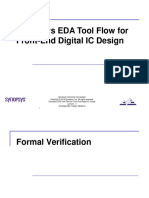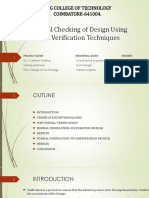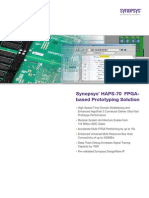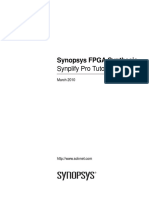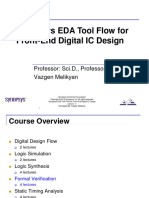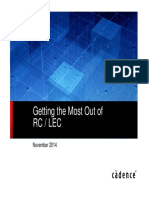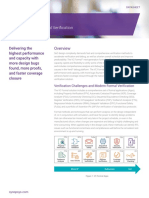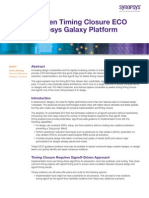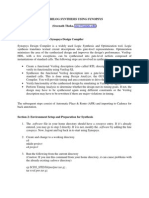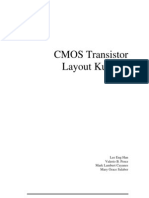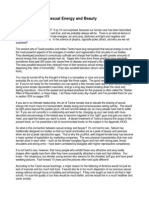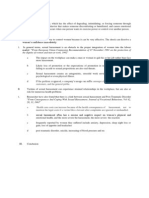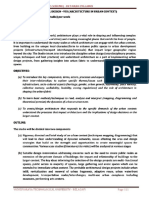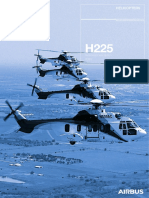DATASHEET
Formality
Equivalence Checking and Interactive ECO
Independent formal Overview
verification of Design Formality® is an equivalence-checking (EC) solution that uses formal, static techniques to
determine if two versions of a design are functionally equivalent.
Compiler and Fusion
Formality delivers capabilities for ECO assistance and advanced debugging to help guide
Compiler synthesis the user in implementing and verifying ECOs. These capabilities significantly shorten the
results, with built- ECO implementation cycle.
in intelligence The size and complexity of today’s designs, coupled with the challenges of meeting
timing, area, power and schedule, requires that the newest, most advanced synthesis
delivering the highest optimizations be fully verifiable.
verifiable QoR Formality supports all of the out-of- the-box Design Compiler® and Fusion Compiler™
optimizations and so provides the highest quality of results that are fully verifiable.
Formality supports verification of power-up and power-down states, multi-voltage, multi-
supply and clock gated designs.
Formality’s easy-to-use, flow-based graphical user interface and auto-setup mode helps
even new users successfully complete verification in the shortest possible time.
RTL
Design Compiler or
Formality
Fusion Compiler
Netlist
Formality IC Compiler II
Netlist
Figure 1: Formality equivalence checking solution
synopsys.com
Key Benefits
• Perfect companion to Design Compiler and Fusion Compiler—supports all default optimizations
• Intuitive flow-based graphical user interface
• Verifies low-power designs including power-up and power-down states
• ECO implementation assistance, fast verification of the ECO, and advanced debugging
• Auto setup mode reduces “false failures” caused by incorrect or missing setup information
• Multicore verification boosts performance
• Automated guidance boosts completion with Design Compiler and Fusion Compiler
• Verifies full-custom and memory designs when including ESP technology
Formality
The Most Comprehensive Equivalence Checking Solution
Formality delivers superior completion on designs compiled with Design Compiler or Fusion Compiler. Design Compiler is the industry
leading family of RTL Synthesis solutions. Fusion Compiler is the next generation RTL-to-GDSII implementation system architected to
address the complexities of advanced process node design. Designers no longer need to disable the powerful optimizations available
with Design Compiler or Fusion Compiler to get equivalence checking to pass. Design Compiler/Fusion Compiler combined with
Formality delivers maximum quality of results (QoR) that are fully verifiable.
Easy to Use with Auto-setup mode
Formality’s auto-setup mode simplifies verification by reducing false failures caused by incorrect or missing setup information.
Auto-setup applies setup information in Formality to match the assumptions made by Design Compiler or Fusion Compiler, including
naming styles, unused pins, test inputs and clock gating.
Critical files such as RTL, netlists and libraries are automatically located. All auto-setup information is listed in a summary report.
Guided Setup
Formality can account for synthesis optimizations using a guided setup file automatically generated by Design Compiler or Fusion
Compiler. Guided setup includes information about name changes, register optimizations, multiplier architectures and many other
transformations that may occur during synthesis. This correct-by-construction information improves performance and first-pass
completion by utilizing the most efficient algorithms during matching and verification.
Formality-guided setup is a standard, documented format that removes unpredictability found in tools relying on log file parsing.
Independent Verification
Every aspect of a guided setup flow is either implicitly or explicitly verified, and all content is available for inspection in an ASCII file.
Figure 2: Automatic cone pruning improves schematic readability when debugging
2
Hier-IQ Technology
Patented Hier-IQ technology provides the performance benefits of hierarchical verification with flat verification’s out-of- the-box usability.
Error-ID Technology
Error-ID identifies the exact logic causing real functional differences between two design representations. Error-ID can isolate and
report several logic differences when multiple discrepancies exist. Error-ID will also present alternative logic that can be changed to
correct a given functional difference; this flexibility allows the designer to select the change that is easiest to implement.
Failing Pattern Display Window
All failing input patterns can be viewed in a familiar spreadsheet-like format. The failing pattern window is an ideal way to quickly
identify trends indicating the cause of a failing verification or improper setup.
Figure 3: Problem areas can be easy identified by visual inspection of the Failing Pattern Window
Power-aware Verification
Formality is fully compatible with Power Compiler™ and verifies power-up and power-down states, multi-voltage, multi-supply and
clock gated designs.
When a reference design block is powered up, Formality verifies functionality. If the implementation design powers up differently,
failing points will occur.
Formality functionally verifies that the implementation powers down when the reference powers down and will detect
functional states where the implementation does not power down as expected. The valid power states are defined in the power
state table (PST).
Power intent is supplied to Formality through IEEE 1801 Unified Power Format (UPF).
Figure 4: Power connectivity is easy to see and debug from the schematic view
3
Accelerated Time to Results
Formality’s performance is enhanced with multicore verification. This Formality capability allows verification of the design using up to
four cores simultaneously to reduce verification time.
Other Time-Saving Features
Formality’s Hierarchical Scripting provides a method to investigate sub-blocks without additional setup and is ideal for isolating
problems and verifying fixes.
The Source Browser opens RTL and netlist source files to highlight occurrences of a selected instance. This can help users correlate
between the RTL and gate-level design versions.
Error Region Correlation provides a quick, visual identification of the logic from one design that correspond to the errors isolated by
Error-ID within the other.
Command Line Editing allows you to take advantage of history and common text editor commands when working from
Formality’s command line.
Interactive ECO
Key Benefits
Provides GUI-driven ECO implementation assistance, fast ECO verification, and advanced debugging. Formality guides the user
through the implementation of ECOs, and then quickly verifies only the changed logic.
Formality Interactive ECO Flow
Formality uses the ECO RTL and an unmodified netlist. Guided GUI driven changes are made to the netlist. Once the ECO has been
implemented, a quick verification is run on only the affected logic cones, eliminating the need for a full verification run on the design
to verify that the ECO was implemented correctly.
Once all ECO’s are implemented and fully verified, a list of IC Compiler™ commands is generated to assist in implementing the
physical changes to the design.
ECO Guidance
Formality highlights equivalent nets between the reference and implementation designs, and nets that have lost their equivalence
due to the ECO changes in the reference. This helps the designer quickly identify where the change should be made in the
implementation.
Implementing the ECO
Editing commands in Formality are used to modify the netlist in-place using the GUI.
Rapid ECO Verification
Formality can identify and verify just the portion of the design affected by the ECO. This ensures that the ECO was implemented
correctly. If the ECO verification fails, the ECO can be interactively “undone” and new edits can be made again. Once the partial
verification passes, the changes are committed. This partial verification eliminates having to verify the entire design to assure that the
ECO was implemented correctly, dramatically reducing the total time required to implement and verify the ECO.
4
Figure 5: Equivalent net is highlighted between Reference design (left) and Implementation design (right)
Figure 6: On a completed ECO, the schematic shows the nets affected by ECO in yellow, and the new component and net in orange
Verification SUCCEEDED
ATTENTION: Only a subset of the compare points was verified.
Use remove_verify_points to do a full verification.
ATTENTION: synopsys_auto_setup mode was enabled.
See Synopsys Auto Setup Summary for details.
--------------------------------------------------------------
Figure 7: Formality transcript shows a successful partial verification of the portion of the design that was affected by the ECO
Interface with IC Compiler II
Once the ECO’s are implemented and verified, a final complete verification run is performed to assure that the ECO RTL and the ECO
netlist are functionally equivalent.
Formality produces IC Compiler II compatible ECO command file, easing the implementation in the physical design.
Advanced Debugging
Formality incorporates advanced debugging capabilities that help the designer identify and debug verifications that do not pass. The
designer can find compare points, equivalences (and inverted-equivalences) between reference and implementation designs, perform
“what if” analysis by interactively modifying the designs, and verify equivalence between two (or multiple) points.
5
Transistor Verification
ESP combines with Formality to offer fast verification of custom circuits, embedded memories and complex I/Os. ESP technology
directly reads existing SPICE and behavioral RTL models and does not require restrictive mapping or translation.
Input Formats
• Synopsys DC, DDC, Milkyway™
• IEEE 1800 SystemVerilog
• Verilog-95, Verilog-2001
• VHDL-87, VHDL-93
• IEEE 1801 Unified Power Format (UPF)
Guided Setup Formats
• Synopsys V-SDC
• Formality Guide Files (SVF)
Platform Support
• Linux Suse, Red Hat and Enterprise
• SPARC Solaris
For more information about Synopsys products, support services or training, visit us on the web at: www.synopsys.com, contact
your local sales representative or call 650.584.5000.
©2019 Synopsys, Inc. All rights reserved. Synopsys is a trademark of Synopsys, Inc. in the United States and other countries. A list of Synopsys trademarks is
available at synopsys.com/copyright.html . All other names mentioned herein are trademarks or registered trademarks of their respective owners.
03/27/19.CS333482482-formality-ds.







